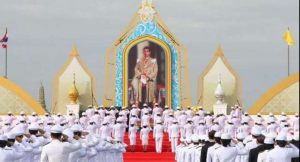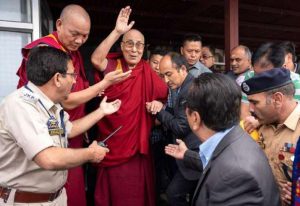
I was fortunate to view the new Bhutanese film The Monk and the Gun on the last day of September in the Woodstock Film Festival in New York. Though modest at present, the Bhutanese film repertoire is growing all the time. Bhutan is a country with much to say, and to teach the world, as a unique country even among Asian Buddhist countries.
It is exciting to see this new film by the director of Lunana, a Yak in the Classroom, Pawo Choyning Dorji, who has worked with Khyentse Norbu, a well-known filmmaker (The Cup, Hema Hema, Sing Me a Song While I Wait, and Vara, a Blessing) as producer and assistant. Not only a Bhutanese filmmaker, Dorji also studied political science, writing, and photography. He has a keen interest in Bhutan’s unique political and cultural development, and a generational perspective that offers much to the outer world.
Dorji’s two films form the foundation of what is sure to be a brilliant and rich career as his view into modern life in Bhutan intersects with traditional ways makes for humor, depth, and great interest. The perspective that he and his characters bring to the film, set in 2006 when the king of Bhutan decided to allow his country to become a democracy, bring intrigue and complications. By stepping down from the throne in what had always been a beloved monarchy, Bhutan is unlike other queen- or kingdoms that are in conflict with democratic processes in other countries. There had always been a peaceful transition of power in Bhutan through their royal lineage. Uniquely, this entrée into voting, elections, candidates, and democratic process set the stage for problems that the country had never faced.
In The Monk, Dorji captures the confusion and tensions for children, parents, elders, and monastics as this transition into a new model unfolds. He deftly weaves various storylines together to form a tapestry of complexity which is both realistic—as it happened—and a nod to Bhutan’s fine lineage of storytelling. Kunzang Choden, Bhutanese author and writer of The Circle of Karma ()tells us there is no word for storytelling in Bhutanese language, but a referral to more of a slow unfolding of a tale:
In Bhutanese tradition stories, fables and legends are not told but are unraveled (shigai in Bumthangkha) and released (tangshi in Dzongkha)… these concept of releasing and unraveling are invested with much significance.
(Core)
Chandra Shekhar Sharma, a lecturer for the college of science and technology at Phuntsholing elaborates, “Folktales have been a tool for Bhutanese society to transfer ideals and values from one generation to another via entertainment.” (Core)

The story of the monk and the gun feels accessible for seasoned Buddhist practitioners of eastern or western descent. It poses questions and situations most of us have never had to think about. After the film, the director gave a talkback from his 3:00 a.m. Bhutan time zone giving us more insight into what this film meant to him and his own experience of being a young person in Bhutan during the transition from monarchy to democracy.
One can only imagine that great things will come from this director and his team. One of the interesting aspects of Bhutanese film is that directors often utilize nonprofessional actors and crew, making for a very realistic feel in the dialogue and situations. Rather than standing apart, this influence made it even more believable. As critic Stephen Farber writes:
Part of the film dramatizes the process of introducing mock elections to teach the people how to vote, which proves to be something of a challenge, since many local residents remain loyal to the king and reluctant to embrace such a dramatic change. Clearly the filmmaker intended a wryly cynical commentary on people’s natural attraction to royalty and authoritarian rule, a theme that remains relevant in many parts of the world outside Bhutan.
(The Hollywood Reporter)
I won’t give away too much of the storyline, as it is worth seeing for oneself. Several interwoven characters and their predicaments make for an entertaining but also meaningful journey through traditional life and rituals, modernity, and their sometimes-awkward meetings. Not only Bhutanese film, but Buddhist films in general are becoming more popular. This can only serve to benefit the general populace by sharing the Buddhadharma in accessible, frank, and enjoyable ways for those new to it.

About the Filmmaker: Pawo Choyning Dorji is a writer, photographer, and filmmaker from the Kingdom of Bhutan. He worked as Khyentse Norbu’s assistant for the latter’s feature film Vara: A Blessing (2012). In 2016 he produced Norbu’s critically acclaimed Bhutanese feature Hema Hema: Sing Me a Song While I Wait. The film had its world premiere at the 69th Festival del film Locarno and went on to win the Special Mention at the 2016 Toronto International Film Festival. His directing debut Lunana: A Yak in the Classroom was nominated at the Academy Awards for Best International Feature in 2021.* Dorji is receiving rave reviews from notable critics and accolades including from the Toronto International Film Festival and Woodstock, NY Film Festival.**

May this film meet great success in distribution, enabling the Director and Team to make more such wonderful films!
* Pawo Choyning Dorji (IMDB)
** The Monk and the Gun (TIFF)
See more
Bhutanese Folktales: Common Man’s Media with Missions for Society, Journal of Bhutan Studies (Core)
‘The Monk and the Gun’ Review: From Bhutan, a Wry Satirical Comedy About Democracy and Violence (The Hollywood Reporter)
Related features from BDG
Film Review: Khyentse Norbu’s Looking for a Lady with Fangs and a Moustache
Book Review: The Ruby Rosary: Joyfully Accepted by Vidyadharas and Dakinis as the Ornament of a Necklace by Thinley Norbu
Tracing the Legacy of Pandita Vimalamitra: A Joint Project of the Ngagyur Nyingma Research Centre and the Khyentse Center for Tibetan Buddhist Textual Scholarship
Related news reports from BDG
Bhutanese Film Lunana: A Yak in the Classroom Nominated for Academy Award














